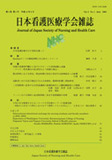Japanese
English
- 有料閲覧
- Abstract 文献概要
- 参考文献 Reference
- サイト内被引用 Cited by
【和文抄録】
本研究は腹式呼吸における呼息と吸息時間の変化が、自律神経系へどのように影響するのかについて検討した。被験者は健康な女子12名で、ベット上に仰向けになり3分間の腹式呼吸を実施した。腹式呼吸は呼息5秒対吸息5秒と呼息6秒対吸息4秒を3分間実施した。腹式呼吸の実施する前、終了後、15分後、30分後、45分後の自律神経活動を心拍変動のパワースペクトル解析によって評価した。腹式呼吸の呼息・吸息各々5秒の場合、心拍数は30分後と45分後に有意な減少を示した。また副交感神経活動の指標としての高周波成分(HF)は30分後と45分後に有意な増加を示した。一方、腹式呼吸の呼息6秒対吸息4秒の場合、心拍数は15分後、30分後と45分後に有意な減少を示した。そして高周波成分は15分後、30分後と45分後に有意な増加を示した。今回の結果は、腹式呼吸時の呼息6秒対吸息4秒は呼息5秒対吸息5秒の場合より、副交感神経活動が優位になった。
【Abstract】
The aim of the present study was to clarify how differences in the abdominal breathing pattern effects the activity of the autonomic nervous system. Twelve healthy female subjects, supine on the bed, were instructed to practice two types of abdominal breathing, namely, 4 second-inhalation and 6 second-exhalation, and 5 second-inhalation-exhalation. Each breathing pattern was continued for 3 minutes. Autonomic nervous activity was evaluated before and immediately, after 15 min, 30 min and 45 min from the beginning of the abdominal breathing, with power spectral analysis of heart rate variability. In the 5 second-inhalation-exhalation pattern, heart rate significantly decreased and HF (high frequency)power, an index of activity of the parasympathetic nervous system, significantly increased after 30 and 45 minutes. On the other hand, in the 4 second-inhalation and 6 second-exhalation pattern, heart rate and HF power showed significant decrease and increase respectively, after 15, 30, and 45 minutes. The results demonstrated that abdominal breathing with the 4 second-inhalation and 6 second-exhalation pattern had superior in the parasympathetic nervous system compared to the 5 second-inhalation and exhalation pattern.
Copyright © 2002, Japan Society of Nursing and Health Care All rights reserved.


